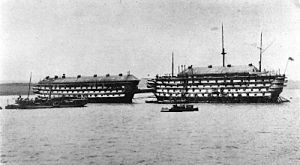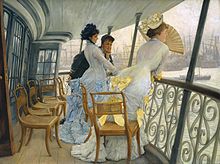HMS Calcutta was commanded by Captain James John Stopford when Arthur Barrow was on board. Stopford had been promoted to Lieutenant the year before Arthur Barrow. The ship, when commissioned, went into dock at Plymouth to have her copper-bottom examined and repaired. Over a period of one month, she was completely rigged by her crew (Cal_1). HMS Calcutta wintered in Falmouth, while Captain Stopford was still attempting to complete his complement of men (a total of 750) by getting seaman to volunteer from merchant ships entering the port (Cal_2). The ship then returned to Plymouth Sound, news of its arrival being sent to the Times and published on the 18th December 1854 having been transmitted via electric telegraph from Plymouth. HMS Calcutta was to join the fleet at Spithead between Portsmouth and the Isle of Wight, where in March 1855 it suffered numerous desertions (Cal_3), and was hit by severe storms and cold (Cal_4). The bulk of this fleet, the Baltic fleet required by Britain during the Crimean War, sailed from Spithead in April. However, the Calcutta with a number of other ships remained to await further orders. It was not until June that, converted into a store ship, she sailed to Sheerness to take on board the armaments of the floating batteries Glatton and Meteor, to be used during a possible attack on Kronstadt on Kotlin island, offshore St. Petersburg, and so proceeded to the Baltic ‘with all possible despatch’ (Cal_5). These floating batteries were the fore-runners of the ironclad battleships to come. In late August HMS Calcutta returned from Kronstadt, taking a week to reach Portsmouth, bringing back invalids from the conflict, while also taking in charge a number of mortar vessels which needed extensive repairs (Cal_6). It was during this period in November 1855 that Commodore Stopford was on the Court Martial of Ordinary Seaman James Vienor who tried to enlist in HM’s 80th Regiment of Foot to obtain bounty given to volunteer recruits. He was charged, convicted and sentenced to 50 lashes and ‘to be imprisoned and kept to hard labour for the space of 12 calendar months in the county gaol of Winchester’ (Cal_7). (A description of the ghastly ordeal was documented for another sailor at a later date (Cal_8)). Towards the end of the Crimean War in March 1856, the Calcutta formed part of a squadron, namely ‘eight sail of the line and eight frigates’ (Cal_9) which received a royal visit from the King of Sardinia accompanied by Prince Albert and the Duke of Cambridge at Spithead. ‘Re-turning into harbour, (the King) boarded the old Victory, and saw where Nelson fell and where he died. From the Victory the King went to the Dock-yard; witnessed a successful experiment with a newly-invented cork life-boat; inspected the blockmaking factory, the shipbuilding yards, the new smiths’ shops, the steam factory. Thence they boarded the Repulse, a new 91-gun ship—to be milled “Victor Emmanuel II,” in honour of this visit – and the Marlborough 131 gun screw ship, the largest man-of-war in the world. … After luncheon, the party went on board the Excellent, and witnessed some fine gunnery. At four o’clock the King left Portsmouth, and returned to Windsor.’ Shortly after this event, the Calcutta arrived at Plymouth Sound ‘appointed to go into Hamoaze, the estuarine stretch of the tidal River Tamar between its confluence with the River Lynher and Plymouth Sound, to be fitted for the flag of Admiral Sir Michael Seymour and subsequent service’ (Cal_10). Arthur Barrow had left the Calcutta prior to the Admiral raising his flag.
HMS Calcutta
An 84-gun second-rate ship of the line launched in 1831, and sold in 1908. She was converted to a gunnery training ship in 1865 and sold in 1908
HMS Calcutta in about 1890. She was converted to a gunnery training ship in 1865, moored at Devonport. Her figurehead was acquired by Admiral Lord Fisher, then First Sea Lord, as Calcutta had been his first sea-going ship.

Gallery of HMS Calcutta moored at Portsmouth about 1876, painted by Tissot.

